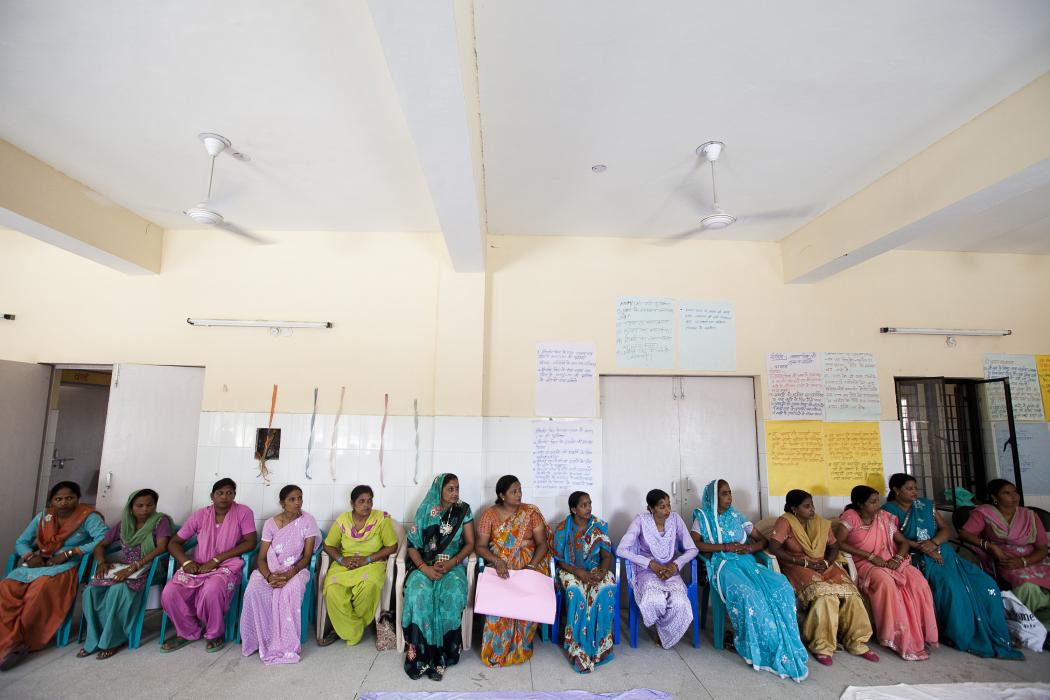Rewriting the Narrative on Women's Empowerment: How Investment in the Health Workforce is Key

By Samantha Rick, Frontline Health Workers Coalition and IntraHealth International. Photo: IntraHealth International
Over the past 30 years we have seen a huge cultural pivot toward “empowering” women and girls, in contrast to men and boys. From the “Girl Power!” movements of the 1990s, through the push for girls’ education in science, technology, engineering, and mathematics (STEM) in the 2000s, to celebrities’ profit-generating self-cultivation of a feminist identity today, it has become fashionable to propose initiatives to increase women’s empowerment. As we commemorate International Women’s Day today, we must stop and ask ourselves what the goal of these initiatives is. As advocates for the global health workforce and gender equity, we need to understand both why women make up the majority in certain sectors, including the health sector, and what we truly mean when we say “empower.”
If the goal is truly to foster an environment that allows for equal participation in society—economically, socially, culturally—between men and women, then many of these initiatives fall short. According to some of these movements, the solution to slow progress in gender equality is to change something about women and girls. The supposed answer is to make girls more confident and to make them act more like boys. But these are the wrong answers to the right questions. They often do not aim at addressing the forces that built this environment which renders these interventions necessary.
The new US Women’s Global Development and Prosperity Initiative (WGDP)—announced by President Trump at the State of the Union and at the White House last month—states its aim to help women “realize their economic potential.” The initiative focuses on three main areas: workforce development, vocational education, and skills training; access to capital, markets, networks, and mentorship; and removing restrictive legal, regulatory, and cultural barriers. It sets aside a commendable $50 million for USAID to develop new programs that fit under those three pillars and directs all of the agencies involved in foreign assistance to give top priority to projects that contribute to the goals set out by the initiative.
International development and health programs have needed significantly more attention to be paid to workforce development issues for decades. For example, the health workforce faces a global shortage of 18 million health workers by 2030 if major new investments are not made. The health sector presents a significant opportunity for the advancement of women, as women make up 70% of the health workforce compared to 41% overall. The consequences of this lack of action are already being felt, especially in communities with the least access to health workers, and the situation will only continue to worsen.
The new US WGDP initiative sends a strong signal that those warnings are being heeded. However, this initiative like others that have attempted to “empower” women before will miss the mark on having maximum impact if it focuses on what women can change about themselves, rather than working with partners to enable structural changes that we as a society can make to the system.
Providing a platform for more women to become entrepreneurs and business-owners will not by itself solve the global problem of women’s low participation in the economy. Men are not more empowered economically because they all own businesses, it’s because they are—and have historically been viewed as—workers. Governments have regularly invested in broad workforce development in the industries that regularly employ men, such as infrastructure, construction, agriculture, and manufacturing. Yet their efforts have fallen short in the industries that typically employ women, such as health, child care, and education. When women’s workforce development initiatives focus on training women in areas that they do not typically operate in, such as entrepreneurship, we miss a huge opportunity to invest in the sectors where women have historically operated, such as health, which would give us a greater return on investment.
Investing in capacity development for health workforce would also benefit the women (and men!) who currently hold those positions, many of whom receive no pay at all—but we need a narrative shift. If decision-makers came to see the immediate and urgent need of the global health workforce that research suggests, then health workers would have more power to negotiate for better working conditions and higher pay commensurate with the job. These changes may also make health a more attractive sector for men’s employment and reduce the occupational gender segregation that drives the global gender pay gap.
True economic empowerment for women will come when all are able to fully and equally participate in the economy. This is only possible if job creation and investment in new opportunities for women is also aligned with sustained investment in the sectors that currently, and historically, employ them—and we encourage the new US Women’s Global Development and Prosperity Initiative to do just that.
As advocates, we need to probe these new initiatives for women’s entrepreneurship and question the system that has been set up to perpetuate inequalities. We need investment in true women’s workforce, a process we can start by committing to investing in the health workforce needed to provide all communities with essential health services.
